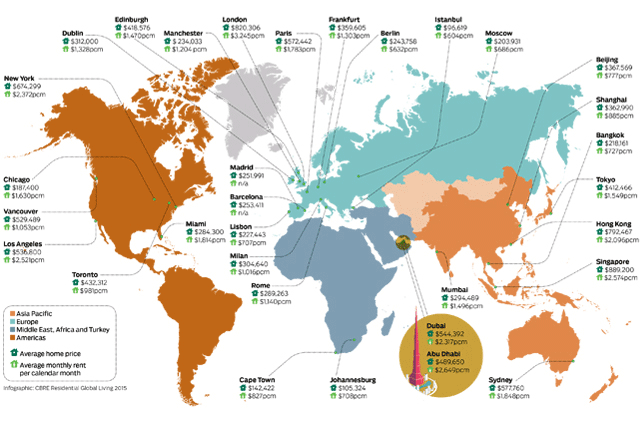
With GDP growth uncertain, stocks dancing about the charts and gold obstinately refusing to shine, real estate has emerged as a strong investment choice. Half of all ultra-high-net-worth individuals in the UAE are thinking of buying property this year, according to Knight Frank.
But what’s a punter to do? Internationally minded by default, the expat investor faces three choices: buy for the present (maybe in the country he lives in), for the future (perhaps to retire to), or simply to stash some cash.
UAE as safe haven
The UAE scores high on two fronts. As a safe haven for regional investors, the country is one of the world’s most investable places, with some very competitively priced real estate and a high quality of life, two new reports say.
According to CBRE’s Residential Global Living report, which was released exclusively to GN Focus, average property prices in Dubai are now around $290 (Dh1,065) per square foot (psf), and around $243 in Abu Dhabi.
At those prices, they aren’t in the ten most expensive cities, where Hong Kong and London sit at the top, with prices of $1,416 psf and $1,025 psf respectively, and New York ($842 psf), Singapore ($810 psf) and Edinburgh ($512 psf) among the rest. Conversely, the lowest — and best value — is Istanbul at $112 psf, the report shows.
At the prime end, London averages around $3,000 psf, while Dubai values are closer to $1,300 psf, says Safina Ahmad, Head of Residential Agency, CBRE Mena, citing cheap labour costs and easy access to high-quality building materials.
“Dubai doesn’t face the same uncertainty over build costs that we’re witnessing in London and purchasers benefit from this,” she said by email.
And it appears that like for like, Dubai offers a better quality of life. “While there isn’t a building of the same perceived quality as One Hyde Park in Dubai (yet), it’s unlikely an apartment building of $300 psf in London will offer the same amenities as one at the same price point in Dubai,” Ahmad says.
“The average house price in the outer boroughs of London would stretch to large apartments in some of Dubai’s most exclusive areas so there’s a sense of greater value. Most Dubai residents enjoy a communal swimming pool and gymnasium. This starts to become more commonplace at around $850 psf in London.”
Regional money
Quality of life is one reason the advisory Savills ranks the UAE as the second-most investable place in the world after the US in its World Residential Markets report, being released today. Softening prices may have underlined just how volatile our property market is, especially in Dubai, but Yolande Barnes, Director of World Research, says the UAE’s fundamentals will hold out. “In five-year terms, investability is very strong,” she told GN Focus.
“Many Middle Eastern investors want their money to stay in the region, so while capital values may fall if supply outpaces demand significantly and investors may withdraw their funds in such a scenario, that only looks mildly likely.
“The market is now much less speculative and a lot less reliant on Western money,” she adds, pointing to the emergence of a ring of regional safe havens. The UAE is a shining example, with high GDP per capita and a forecast of strong population growth — Dubai alone will be welcome one million new residents in ten years.
A prime two-bedroom apartment in Dubai costs about $1.9 million, while one in Hong Kong, the most expensive — and theoretically the best asset — is priced at $4.5 million, Savills says. With prices in the Asian city expected to grow more slowly, even the Chinese are exiting in favour of the US. As the number two market, then, it might just be the right time to buy into the UAE.
And though prices may decline further, the UAE’s economic strength will work in its favour, Yousuf Wahbah, Mena Real Estate Transactions Leader at the services firm EY, told GN Focus. Despite low oil prices, he says the GDP growth forecast of 3 per cent in 2015 looks achievable.
“The UAE’s strength as a tourist destination, trade and financial centre coupled with its reputation as a safe haven for investors will continue to fuel growth in the country’s markets over the coming years, with Expo 2020 acting as another catalyst,” he says. “The property market in the UAE is softening as compared to 2014. This is expected to continue in 2015 with stabilisation over the next few years.” In short, buy to live or buy for the medium term, but not for quick returns.











